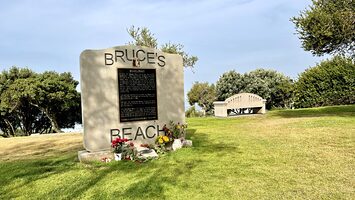The Story of Bruce Beach: How Black Property Rights are Civil Rights
No matter how hard black entrepreneurs worked or how impressive the businesses they built, they could still have it all taken away from them by white supremacists.

Bruce’s Beach—now a part of Manhattan Beach in Southern California—held a special distinction as a popular resort area catering to Black Americans during the early 20th century.
In 1912, the titular couple, entrepreneurs Willa and Charles Bruce, left New Mexico and purchased a pristine piece of waterfront property in the sparsely developed and unincorporated town that would become Bruce’s Beach, California. Situated on a slope overlooking the ocean, it possessed grassy terraces, lush trees, and many park benches.
Located between 26th and 27th streets and running west from Highland Avenue to Manhattan Avenue, the parcels of land were purchased from George H. Peck, a white, millionaire developer and the community co-founder.
It was the era of Jim Crow racial segregation, so the Bruces confronted exclusionary real estate practices when acquiring the land. Interviewed by the Los Angeles Times in 1912, Ms. Bruce noted:
Whenever we have tried to buy land for a beach resort we have been refused. But I own this land and I’m going to keep it.
Indeed, while Peck was often credited for having transcended the practice of racial exclusion because of the sale to the Bruces, he had actually ordered that security personnel and “no trespassing signs” be placed on the outer perimeter of the area in order to discourage black out-of-town visitors from frequenting the beach.
Despite the barriers, Willa, a business visionary, persisted in opening the resort in 1912 with the aim of providing black Americans a leisure experience near the ocean. Known as Bruce’s Beach Lodge, this much celebrated locale welcomed black beachgoers with a dining establishment, dance hall, a changing area, and offered bathing suits for rent. With her husband employed as dining car chef on a train line from from L.A. to Salt Lake City, Willa oversaw the day-to-day operations of the resort.
For a period, Bruce’s Beach was considered a safe respite for black visitors. The area was often frequented by famous black entertainers, actors, jazz artists, and politicians. As the resort expanded, a number of black families migrated to the area permanently, purchasing or building cottages in the area.
But given its growing popularity as one of the few Southern California beaches open to black families, racial hostility from local white residents mounted. According to historian Robert L. Brigham, many whites feared an “invasion” or takeover of the area by the black community. This led white residents to set up barricades to prevent black beachgoers from gaining access to the ocean.
White supremacists also attacked the resort and its visitors. They slashed tires in the parking lot, burned mattresses underneath the resort building structure, and left threatening, racially derogatory phone messages, all to discourage blacks from frequenting the area.
When these harassment attempts failed, public officials stepped forward with an initiative to steer blacks out of the area. Utilizing eminent domain, in 1924 the City of Manhattan Beach seized two dozen properties belonging to the Bruces and four other families under the guise of needing to establish a new public park in the area.
The Bruces and other families sued, alleging that the taking of their properties was discriminatory in its intent. But despite repeated legal efforts to reclaim their assets, the Bruces were forced out of the city and their prized resort was shuttered and demolished. They did win partial compensation from the eminent domain process, but it did not come anywhere close to covering the damages inflicted; the couple had requested $120,000 but were granted a mere $14,500 by the city.
In 1927, an attempt on the part of the city at leasing the Bruce’s land with the intent of establishing a whites-only beach was met by fierce resistance from the NAACP, which launched a civil disobedience campaign. Protesters that were arrested challenged the charges and were released. And they succeeded in halting the plans.
That was cold comfort for the Bruces. With their property taken from them, they elected to move inland to central California, working the balance of their lives as chefs and in other, smaller business ventures. For years the old property remained vacant until finally a park was hastily built there in 1950, allegedly out of concern that the Bruce family would mount another legal battle if it remained empty.
Bruce’s Beach offers a poignant example of how land theft through both violence and the legal system has impacted black wealth and social advancement. For generations, black landowners like the Bruces have been victimized by eminent domain and unjust property restrictions. Families found little recourse in recovering these properties often due to state statutes of limitation. Black property rights are civil rights.
However, in a groundbreaking move on September 30, 2021, the State of California authorized the county to return the land back to the Bruce family’s descendants nearly 100 years after Willa and Charles had been evicted.
Resources:
A Black family got their beach back — and inspired others to fight against land theft, NPR, October 10, 2021.
What Happened at Bruce’s Beach, Easy Reader and Peninsula News, June 19, 2021